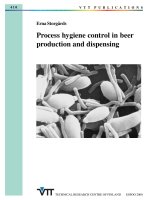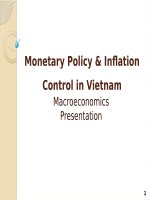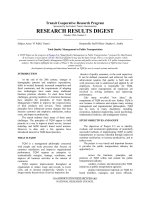Quality Control In Textile
Bạn đang xem bản rút gọn của tài liệu. Xem và tải ngay bản đầy đủ của tài liệu tại đây (340.55 KB, 19 trang )
QUALITY CONTROL IN
TEXTILE
DEFINITION
QUALITY CONTROL:
"The systems required for programming and coordinating the efforts of the various
groups in an organization to maintain the requisite quality”.
OBJECTIVES:
To maximize the production of goods within the specified tolerances correctly the
first time.
To achieve a satisfactory design of the fabric or garment in relation to the level of
choice in design, styles, colours, suitability of components and fitness of product for
the market.
QUALITY CONTROL IN TEXTILE
Every operation under wet processing such as pre-treatment, dyeing, printing
or finishing irrespective to its specific aim in desired product finds its basis in:
Maintenance of high quality
Cost effectiveness
Improved functionality
Lower generation of waste
Minimum use or reuse of water and chemicals
Overall environment friendliness
Application of appropriate machinery and technology
ON-LINE QUALITY CONTROL SYSTEM
This type of quality control is carried out without stopping the production
process. During the running of production process a set up automatically
performs and detect the fault and also takes corrective action.
Raw Material Control
o
Best quality raw materials with economical consideration
o
The fabric must be without fault, with proper absorbency, whiteness as per
requirement of the subsequent process.
Process Control
o
Process with accurate parameters
OFF-LINE QUALITY CONTROL SYSTEM
Performed in the laboratory and other production area by stopping the
production process consisting of fabric inspection and laboratory and other
test. Correction steps are taken according to the test result.
All the Off-Line tests for finished fabrics can be grouped as follows:
o
Physical tests
o
Chemical tests
Specified test methods of AATCC, ISO, ASTMD, M&S, DIN, JIS etc.
PHYSICAL TESTS
•
Identification of fiber physically
•
Count & construction of fabric
•
Blend Ratio
•
Abrasion, Pilling & snagging
•
Strength (Tear, strip, seam slippage, cyclic and bursting)
•
Dimensional stability
•
Appearance test
•
Crease recovery
•
Air permeability/down proof test
FASTNESS TESTING
•
Light fastness
•
Washing fastness
•
Dry Cleaning
•
Perspiration
•
Cold Water and Sea Water
•
Yellowing
•
Dry heat and hot pressing
•
Sublimation
•
Rubbing Fastness (Crocking)
CHEMICAL TESTS
•
Determination of Formaldehyde content
•
Percentage Purity of Acids & Alkalis
•
Auxiliaries for application of wet processing
•
Viscosity
•
pH
•
Tests for variety of Functional Finishing
•
Flammability
•
Water & Oil repellency test
•
Soil/Stain release test
TENSILE STRENGTH
A test piece is held in two or more places and extended until
it breaks. The tensile properties measured are generally
considered arbitrary rather than absolute. Results depend
on specimen geometry, the fiber type and arrangement, as
well as the fabric structure.
Standards commonly used for tensile strength tests are as
follows:
o
ISO 13934-1:1999
o
ASTM DS 034-95
TENSILE STRENGTH
FABRIC ABRASION RESISTANCE:
To abrade the sample until a predetermined end-point
is reached, such as the breaking of two threads or the
generation of a hole, while recording the time or
number of cycles to achieve this
Many different standards are used worldwide for
abrasion resistance tests, including:
o
ISO 12947-1-1998
o
ASTM D 3884
FABRIC ABRASION RESISTANCE:
o
A four-inch diameter specimen
normally less than 12.5mm
thickness is mounted on a rotating
turntable.
o
Abrasive wheels are applied to the
sample using a fixed weight.
o
For a specified number of cycles,
the abrasive wheels wear away the
sample.
o
The result is calculated by
measuring the weight loss per
thousand cycles of abrasion.
CROCKING RESISTANCE
To measure for colorfastness to crocking, the fabric to be
tested is rubbed with squares of white cotton fabric (wet
and dry) under controlled pressure for a specified number
of times. The amount of color transferred to the white test
squares is matched to a control chart and a rating is
established.
Standard commonly used for Crocking resistance test is as
follows,
o
AATCC 8
CROCKING RESISTANCE
ULTRA-VIOLET LIGHT RESISTANCE
To measure for colorfastness to light, the fabric to be tested
is exposed under specific conditions to a controlled light
source which simulates the sun’s rays. At timed intervals,
the test swatch is compared to a gray scale and the degree
of fading is rated.
Standard commonly used for Crocking resistance test is as
follows
o
AATCC 16A
DETECTION OF FORMALDEHYDE IN TEXTILES
A weighed fabric specimen is suspended over water in sealed
jar. The jar is placed in an oven at a controlled temperature for
a specified length of time.
The amount of formaldehyde absorbed by the water is then
determined colorimetrically.
Test method
o
AATCC 112-2008
FLAME RESISTANCE
VERTICAL FLAME TEST:
o
Fabric is mounted in a vertical holder and exposed to an open flame for a specified
amount of time. Once the flame is removed, the after flame and char length of the
test sample are measured against various code standards to establish a classification.
o
ASTM D6413
TUNNEL TEST:
o
Fabric is clamped or glued to a substrate, which is placed on the ceiling of test
chamber and ignited by a flame below. Fabric is then evaluated for the density of the
smoke formed, the amount of fuel contributed and the extent of the flame spread.
Rating is established based on these factors.
o
ASTM E84
FLAME RESISTANCE
OILY STAIN/SOIL RELEASE TEST
A stain is applied to a test specimen. An amount of the staining substance is
forced into the fabric by using a specified weight.
The stained fabric is then laundered in a prescribed manner and the residual
stain rated on a scale from 5 to 1 by comparison with a stain release replica
showing a graduated series of stains.
Standard method
o
AATCC 130-2010









